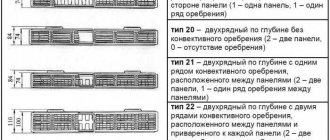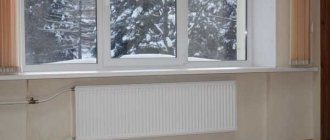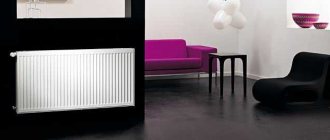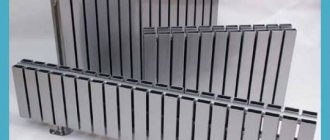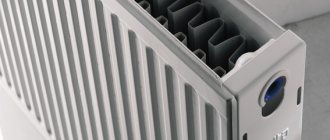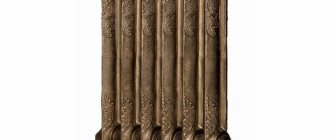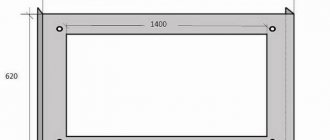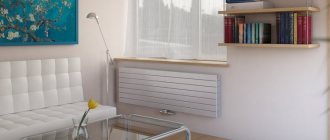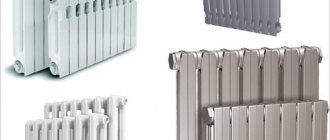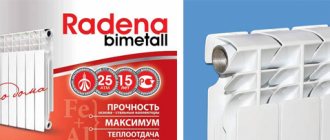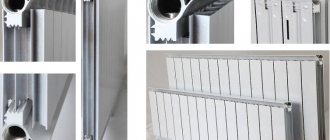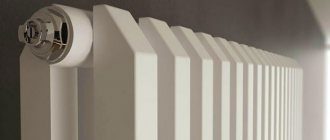Conrad
The Russian manufacturer produces all types of panel radiators with side and bottom connections.
In the kit of each device, additional parts are provided: brackets, Mayevsky crane, plugs, nozzles.
Konrad produces batteries that are suitable for use in closed heating systems.
Output
Everything that we have described to you is theoretical knowledge that will help you understand and choose the most suitable model for your living space. At the same time, we advise you, after reading this article, to study the models with your own eyes, to consult with the sellers, because much depends on certain features of the room in which the radiators will be installed.
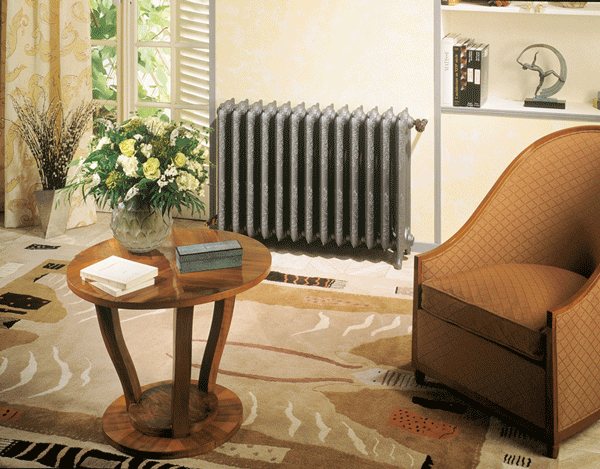
Cast iron radiators are quite heavy, so it is better to purchase not wall appliances, but floor ones with legs
In the video presented in this article, you will find additional information on this topic.
Did you like the article? Subscribe to our channel Yandex.Zen
Kermi
Manufacturer from Germany, existing and actively conducting its production activities for over 50 years. In terms of their structure, Kermi panel-type radiators are very similar to conventional ones.
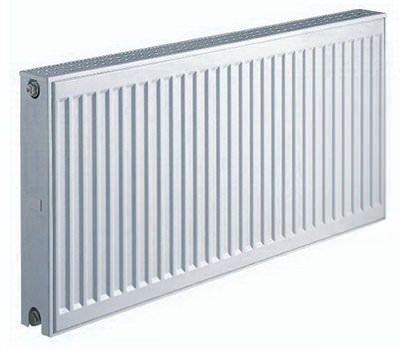

Steel Radiator Kermi
The panels are constructed from two plates with a recess between them. It is there that the process of circulation of the coolant is carried out. All manufactured radiators are characterized by the highest quality that meets European standards.
The latest equipment is used in the production process. The batteries are distinguished by good heat dissipation, ahead of their competitors in this indicator by 20-30%.
The company has developed its own Therm X2 technology.
The produced batteries are more suitable for closed heating systems.
The manufacturer Kermi offers a wide range of radiators with both side and bottom connections. And the variety of designs allows everyone to choose the most suitable option for their home.
Heating radiators: a brief overview of the market
Cast iron
Until now, cast iron radiators were considered the undisputed leaders in the mass radiator market. Today their share is about 50% of the market volume and it is rapidly falling, giving way to more modern aluminum and bimetallic models. Advantages of cast iron radiators: neutrality in relation to almost all heat carriers; withstand a sufficiently high pressure; the share of radiative heat flux is about 70%, and convective - 30%, which ensures good heating of both the lower and upper zones of the room; service life - at least 50 years; low cost (however, it is worth noting that cast-iron radiators of Western production are often significantly higher in price than radiators of other types). Disadvantages: they do not tolerate water hammer; require mandatory broaching of intersection connections before installation and additional painting; labor intensity and relatively high cost of installation (about 30–40% higher than the installation of steel or aluminum radiators). A classic example of a cast-iron radiator is the "accordion" familiar to many generations of Russians (model MC-140). But now she is no longer alone, cast iron appliances are produced by Viadrus (Czech Republic, Kalor and Termo models), Roca (Spain, Duba series), Konner Beijing Pioneer Radiator Co. (China), Demir Do..ku..m (Turkey), Minsk Heating Equipment Plant (MZOO, Belarus), as well as the Cheboksary Aggregate Plant (ChAZ) and the Bryansk Plant in Lyubokhna. In recent years, the volume of sections of cast iron radiators has significantly decreased, which reduced thermal inertia and made it possible to automate the radiator control using a thermostat.Such thermostats are produced by MZOO (model 2K-60P) and Cheboksary Aggregate Plant (model ChM2). In addition, the frontal surface of the instruments became flat, as a result of which they acquired the resemblance to aluminum samples. These are the aforementioned 2K-60N / P and ChM2, as well as “Ridem” radiators from Demir Do..ku..m with low hydraulic resistance. For lovers of retro, radiators with a surface decorated with a convex ornament are offered. One of the largest manufacturers of cast iron radiators is a Czech company
Viadrus
... The standard delivery contains radiators assembled in 10 sections, painted with anticorrosive primer paint. The guarantee is 10 years. Radiators of the Kalor, Kalor 3, Termo and Bohemia, Styl types are in good demand. The models differ from each other with minor improvements. The Kalor type, which is currently produced in eight variants, belongs to the company's traditional products. A newer series is the Kalor 3 type with a frontal longitudinal rib, which, after the sections are tightened, forms a panel wall. Radiators of this type are available in five standard sizes. The advantages are high power and pleasant appearance. A novelty for the Kalor and Kalor 3 cast iron radiators is the Viadrus ITV thermostatic valve, which is installed on the right side of the radiator. The valve is equipped with a thermostatic head for setting the required room temperature. The progressive series is made up of a new type of sectional cast iron radiators - Termo with a front panel wall. This series belongs to the class of decorative cast iron radiators. Unlike the Kalor and Kalor 3 types, Termo has a 25% lower water capacity at the same heat output. The nipple connections are threaded 1˝. Thanks to the modern design, it was possible to achieve a good combination of power in relation to the weight of the cast iron radiator. Company
Kinhil Cast-Iron
(China) manufactures radiators from high quality cast iron, which are not susceptible to poor quality of the coolant. The devices have a large heat removal area due to the special design of the petals and guarantee maximum heat transfer at minimum cost. Supplied covered with baked polyester enamel (technical parameters: working pressure - 12 atm, section height 580 mm, section width - 60 mm, depth - 85 mm). Konner cast iron radiators manufactured by Beijing Pioneer Radiator Co. (China), meet modern aesthetic requirements and are of high quality at an affordable cost. Models "Modern", "Hit" with a center distance of 300 and 500 mm are not inferior in appearance to European aluminum and bimetallic radiators. The company can produce radiators in any style, from the most modern, such as the Olympic model, to decorative radiators in the style of the early 20th century. with ornament. All devices from this manufacturer are designed for a maximum overpressure of 12 atm, test pressure - 18 atm. They can be used both in a country house and in a city apartment. Pig-iron decorative radiator "Retro"
Demir Do..ku..m
(Turkey). The working pressure of the radiator is 9 atm, the test pressure is 15 atm. The radiators are primed and ready for painting in any color, available with a center distance of 500; 600 and 800 mm. Under the new Russian brand CHE. RAD produces radiators
Cheboksary Aggregate Plant
... The assortment is presented in various models. A characteristic feature of CHE.RAD radiators are wide collectors and vertical channels: if necessary, they can be subjected to alkaline flushing without any damage. Working pressure in CHE.RAD cast iron radiators reaches 9 atm. Each device is subjected to a complete pressure test for a minute at a pressure of 18 atm, while for cast-iron radiators with a working pressure of 9 atm. GOST defines a test pressure of 15 atm. This is due to the manufacturer's plans to certify all devices of the FM series for an operating pressure of 12 atm. At present, OJSC "ChAZ" is testing radiators with a working pressure of 18 atm.Center distance of CHE.RAD radiators - 300 and 500 mm, set 5; 7 and 9 sections.
Aluminum
Advantages of aluminum devices: beautiful casting, light weight, high heat transfer, low inertia, the highest thermal power / cost. They are produced in two versions: cast (each section is a single piece) and extrusion (each section consists of elements - head, rib and bottom, which are glued together). Most of the cast radiators, adapted to Russian conditions, are designed for an operating pressure of 16–20 atm (the standard actually became 16 atm), and for extruded models the declared safety factor is on average from 10 to 40 atm. The design of extruded radiators allows them to withstand fairly high pressures, but they also have a potentially dangerous place - the connection of the columns with the manifolds. According to the general opinion of experts, based on practice, cast models are preferable, if only because the percentage of return on them is lower. It is necessary to pay close attention to the presence of antagonist metals in the heating system, because the presence of a galvanic pair "aluminum-steel" or "aluminum-copper" can lead to electrochemical corrosion of the devices. To reduce the risks, it is necessary to use special pass-through plugs during installation - nickel-plated, chrome-plated or cadmium-plated. In the Russian market of aluminum radiators, there are mainly Italian companies: Fondital, Sira, Global, Faral, Rovall, Royal Thermo, Ferroli, GruppoRagani, Ideal Comfort, Mectherm, Radiatori 2000, Ragall. Extrusion aluminum radiators are made by extrusion from ductile aluminum alloys, and the upper and lower collectors are made by injection molding. The resulting parts are glued together with a special glue. The vast majority of European aluminum radiators are die-cast to provide the strength and corrosion resistance required for our systems. The largest manufacturers (Fondital, Ragaini, Global, Indistrie Passoti) use only this technology for radiators supplied to Russia. There is also hybrid technology. For radiators Alux of the Italian company
Rovall
, part of the Sira Group holding, collectors are cast for two and three columns at once. In this case, a block radiator is obtained with a step of two or three sections. The upper and lower manifold blocks are connected to two or three columns by electrochemical welding. The circular cross-section of the coolant passage ensures high strength of the radiator column. Connecting radiator blocks using steel nipples and special gaskets allows you to select the required heating surface area when ordering the device. Italian factory
Faral S.p.A.
, part of the Swiss concern
Zehnder Group
, developed especially for the Russian market the world's first and only cast aluminum radiator of two-channel design - Faral Trio HP. The new product can withstand burst pressure over 60 atm. For most manufacturers of cast aluminum radiators, this figure does not exceed 45 atm. According to the ABOK standard, issued in 2005, the burst pressure should be three times higher than the working pressure, i.e. with a declared working pressure of 16 atm, the burst pressure must be at least 48 atm. The Faral Trio HP radiator has a high heat dissipation (up to 212 W) due to the fact that such a design made it possible to use the maximum number of lamellas - six. The production technology of the Faral Trio HP radiator is based on the developments of the 70s. The equipment of that time did not allow the production of a two-channel design. We returned to the idea at the beginning of 2006, when the requirements for the strength of radiators were increased in Russia. A unique technology developed by the engineers of the Faral S.p.A. plant. under the leadership of the technical director Mr. Masetti. At the same time, the recommendations of the specialists of Vitaterma, Sanros and the Research Institute of Plumbing, who visited the plant in 2006, were taken into account.The patented production process of the two-channel design provides for the feeding of a hot aluminum alloy into a special mold with the parallel entry of two circular knives that form channels for the future radiator. The production is carried out with high precision: the slightest vibrations of the knives are excluded, which ensures the strength of the structure. To ensure maximum alloy composition uniformity, only primary aluminum is used. There are two models of Faral Trio HP radiators on the Russian market: P 350 and P 500 (center distance - 350 and 500 mm). Radiators are delivered assembled in lengths from two to 16 sections. Each device is tested with an overpressure of 24 atm. The Trio model, like all Faral products, has an internal anti-corrosion treatment, which ensures reliable operation when connected to heating systems. This year, supplies of an aluminum sectional radiator have begun to the Russian market
Manaut
Open HP (Spain). The new model has received a redesigned design and a reinforced structure, which is designed to provide high heat transfer and reliability in central heating systems. The Open HP model is designed specifically for use in central heating systems in Russia and the CIS countries, as evidenced by the "HP" (high pressure) index. The advantages of the radiator include an attractive design and high heat transfer: for a section with a center distance of 500 mm, this figure is 199 W. The working pressure of the radiator is 16 bar, the test pressure is 24 bar. In addition to high technical characteristics, another difference between Manaut radiators is an attractive cost compared to other radiators made in Europe.
Bimetallic
Despite the "aluminum" appearance (radiators have a steel core and an aluminum jacket and are designed to operate at high coolant pressures in the system), they should still be assigned to a special group. Factory
Sira
(Italy) has been producing these radiators for over 30 years, in Russia the history of their operation is about 15 years. The design of the devices, protected by the Sira patent, is such that the safety factor is many times greater than all possible pressures in the system, the contact of the coolant with aluminum is practically zero. The section connection unit is originally made. The recommended area of application (due to the high pressure in the heating system) is urban residential and non-residential buildings and structures. Application in cottage construction is economically impractical, since high pressure in the system is excluded. The most famous manufacturers of sectional bimetallic radiators in Russia are Royal Thermo, Global, Rovall and Sira (Italy). Elegant and powerful, these appliances are highly water resistant and corrosion resistant. In the spring of 2007, the first batches of new radiators appeared on the market
Konner
Bimetal. They continue the line of high-quality heating devices offered, and are designed specifically for operation in Russian conditions. The radiators are highly durable thanks to the high-alloy steel internal manifold. Thus, the aluminum does not come into contact with the heat carrier, so the radiator can operate on a heat carrier of any quality, regardless of the pH-factor level.
Steel panel
Steel panel radiators are very popular in Russia, such brands as Purmo, Kermi, De Longhi, Vogel & Noot are well known. Today, manufacturers produce devices of various shapes, are constantly working to improve hygiene, and expand the range. Attention should be paid to the modification of the Plan-Hygiene hygienic radiator from
Kermi
(Germany). This radiator has from one to three panels in depth, is manufactured without fins, air outlet grille and side walls, painted with antibacterial paint and is intended for heating medical institutions.High-strength radiators of the Samba model from Chappee (France), panel radiators of increased trauma Vonova from Vogel & Noot (Austria), as well as new modifications of radiators from Korado (Czech Republic) and Purmo (Poland) are also of interest. Company
Vogel & Noot
(Austria), a member of the Rettig ICC group - the world leader in the production of steel panel radiators, offers the Vogel & Noot T6 model - a radiator with a central outlet. This arrangement greatly facilitates the installation of the radiator and pipes. presents a new valve radiator from the company
Kermi
- "Term X2". The “Term X2” principle is simply brilliant. The operation of Term X2 radiators is based on a new principle, in which the coolant flow is organized sequentially: the front panel is connected in series with the panels located behind it. As a result, the heating medium first flows through the front panel. Such an original solution opens up great prospects: the heating process proceeds more dynamically, comfort and energy efficiency increase. The "Term X2" radiator has a coefficient of efficiency equal to which no other standard flat radiator has. The rear panel barely gets warm during normal operation. Due to the lower heat transfer from the side of the wall, this panel acts as a heat radiation shield. All this leads to a reduction in energy costs by about 6%. The debutant of the year in the Russian market of steel panel radiators is a German company
HM-Heizkerper
, which offers a wide range of these devices. For example, Centara is a model with a central connection, 60 overall dimensions of the model have been developed, up to an overall length of 2 m. Another model - Classic - is an extra-class profile radiator that meets even the most specific requirements for installations with an operating pressure of 10 bar. The Classic model is available in two versions: compact and compact valve. From domestic
(St. Petersburg) together with Danfoss CJSC
mastered the production of steel panel radiators "Konrad Thermo" with a built-in thermostat RTD-N for two-pipe heating systems and RTD-G - for one-pipe. The designs of these panel radiators are designed for a maximum operating excess pressure of the coolant of 10 atm and have modifications for both side and bottom connection of the connecting pipes.
LLC "Izhevsk plant of thermal equipment"
, which produces panel radiators of increased strength Prado (operating pressure up to 1 MPa), increases its range by reducing the nomenclature spacing between panels to 100 mm with a total radiator length of less than 2 m and up to 200 mm - with a device length over 2 m. In addition, the enterprise has launched the production of radiators with increased heat density. The high professional level of the specialists of this plant made it possible to ensure the welding of panels made of steel sheets with a thickness of 1.4 mm practically without external traces of welding points and seams. Prado-Classic radiators are manufactured in the traditional profile design with four connecting holes. The Prado-Universal model is equipped with built-in thermostats and bottom connections.
LLC "Santekhkomplekt"
presents a novelty in 2007 - steel panel radiators Panelli (Celikpan). The radiators are made of high quality low carbon steel with improved properties. The design features of the new products provide versatility of connection and thermoregulation. A wide range of Panelli sizes, which is represented by one-, two- and three-row models with or without ribbing, lateral and universal connection, lengths from 400 to 3000 mm, heights from 300 to 900 mm, will become a great convenience for the buyer. The diameter of the radiator connecting holes is ½˝.
Steel tubular
A relatively new and actively developing type of devices on the Russian market. From a constructive point of view, they are developing in two directions. In the first case, individual sections from two to six columns deep are welded together to form a radiator.In radiators of a different type, pipes are welded to one-piece collectors on one or two sides (depending on the modifications). Smooth curves of the tubes reduce the risk of injury and help to create openwork designs that fit well into any interiors. The devices are hygienic and easy to clean. The first type of radiators in terms of heat transfer is almost as good as panel devices (in the same dimensions). The size range is very wide due to the specifics of production, standard models have several dozen positions, to order, devices can be made in radius and angular design. This is a real find for a designer: different shapes of tubes - round and flat, radiators in the form of trapeziums, arches, columns, as balusters for stair rails or benches - literally for every taste and imagination of the customer. The range of heights of tubular steel radiators is very wide - from low (19 cm) to high (6 m). No other type of radiator can boast such a variety of standard models. The second type of devices is produced by Kermi and OOO PF KZTO (Kimry, Tver region). Domestic radiators keep working pressure up to 15 atm. On the Russian market, steel tubular radiators are most widely represented by two German companies - Arbonia and Zehnder. They are similar in design, dimensions, technical characteristics and cost. Company
Zehnder
offers radiators painted in more than 700 RAL colors with a standard extra charge and a standard delivery time. The working pressure can be increased up to 18 atm. When using steel radiators, it should be remembered that they are very sensitive to the quality of water treatment, especially to the content of oxygen and contaminants (sludge) in the water. Therefore, radiators are recommended to be used exclusively in independent heating systems with closed expansion vessels, modern circulation pumps, as well as with devices for replenishing deaerated water from a water supply system or directly from a heating network. To reduce the risk of under-sludge corrosion, it is advisable to install additional mud collectors, and when using thermostats and automated air vents, also filters. Knowing the peculiarities of Russian heating systems, Zehnder offers a Charleston Pro radiator, which has a special patented anti-corrosion coating consisting of many overlapping zinc and aluminum particles. This model with a service life of more than 25 years can be installed in heating systems with any existing parameters, both open and closed. The radiator combines the best qualities of cast iron and steel appliances - resistance to oxygen along with modern design, low inertia and fairly high heat transfer.
Let's look into the future
On the threshold of the new century, an attempt can be made to forecast the future of heating devices. We will proceed from the fact that heat loss in our homes will decrease by two or three times. The number of required radiators will be reduced. Their power and size will decrease, and the requirements for heat comfort will increase. Therefore, the transition to low-temperature systems that require lower costs is inevitable. Of the existing types, panel and tubular radiators will receive new development, for example, with decorative design for wall materials. More designer radiators will appear. For example, a novelty from
Jaga
- Heatwave radiator from designer Joris Laarman and Droog company (Amsterdam). A baroque radiator in the form of lace flowers is placed directly on the wall, it will give warmth and comfort, including marvelous floral charm. Heatwave is an industrial modular design, the elements of which can be easily interconnected to form a radiator of any configuration. The result is an optimally functioning wall decoration that provides excellent heat transfer.It turns out that constructions that have a purely utilitarian purpose are also not alien to style, and the severity of execution is not always more functional than magnificently decorated forms. Heatwave radiator material - polyconcrete (sand-filled polyester), color - light gray, module dimensions - 70 × 50 cm, weight - 12 kg, power - 200 W / module. Another example of unusual design radiators is the Dualis radiator model from the concern
Zehnder Group
... It is available in two versions: the Dualis Plus design radiator with chrome-plated towel holder and the Dualis Vertical or Horizontal radiator. Zehnder Dualis is manufactured in two materials: the inner structure in steel, the front wavy decorative panel in anodized aluminum. The aluminum screen not only increases the heat transfer of the device, but also serves as an interior decoration. Chrome-plated towel holders, fittings and decorative covers are also functional and aesthetically pleasing. The Dualis radiators are the creation of the renowned design group Perri King and Santiago Miranda (Milan). In 2005 they received the Design Plus Award and in 2007 the Plus X Award, not only for design, but also for functionality.
Korado
A Czech company that has achieved good results in the production of steel radiators. Users leave a lot of positive reviews about Korado products and note their high quality and durability.
The batteries can be installed both in one-pipe and two-pipe heating circuits with closed and open circulation of the heat carrier.
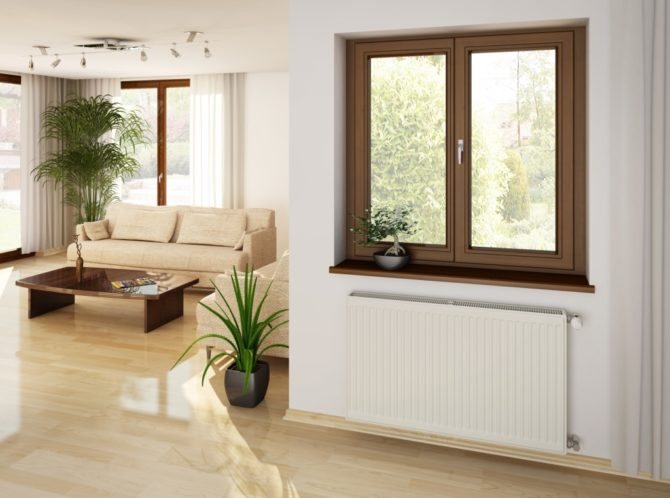

Radiator Korado Radik Klasik
All manufactured radiators are presented in 4 series: Radik Hygiene, Radik Klasik, Radik Plan, Radik Ventel Kompakt.
Purmo
A well-known Finnish company that uses cold-rolled 1.25 mm steel for the manufacture of almost all panel radiators.
Batteries are painted by cataphoresis, therefore they are resistant to corrosive processes.
You can find out what paint to use for painting batteries in this article.
The lineup is presented in the following line:
- Purmo Compact C - side connection;
- Purmo Ventil Compact VKO - models with both bottom and side connections and are equipped with a thermostat;
- Purmo Hygiene P - lateral connection, no convection elements;
- Purmo Ventil Hygiene PV - without convection elements, but the kit includes a thermostat, two connection options: bottom and side;
- Purmo Planora Plan DF has side and bottom connections and is characterized by a smooth radiator screen.
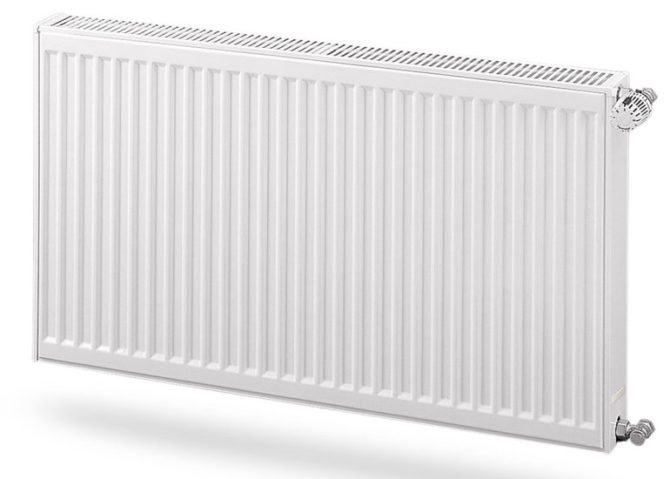

Steel radiators PURMO Compact
Advantages and disadvantages ↑
Steel radiators, in comparison with others, have the following advantages:
- Durability. Provided by the simplicity of the design.
- Strength. Radiators are made of thick steel (up to 1.5 mm), so they are able to withstand a certain pressure.
- Modern design. Radiators are versatile and can fit into any interior.
- Low cost. Especially Russian-made models.
- High heat dissipation. According to this parameter, steel batteries are inferior only to aluminum ones.
- Ease of installation.
The main disadvantage of steel batteries is their tendency to corrosion. Therefore, it is not recommended to leave them without water for more than two weeks. the corrosive effect increases. The welds used to connect the panels are susceptible to water hammer. There are times when, when pressing the system, they are deformed or burst. If a poor quality radiator was chosen, you can expect the paint to peel off after a few years.
Prado
Russian manufacturer that produces batteries with side and bottom connections.
The products are characterized not only by high quality, but also by a pleasant price.
Radiators are distinguished by high rates of heat transfer, they are quite durable and, with proper care, can last for many years.
Prado products are presented in two lines: Classic and Universal.
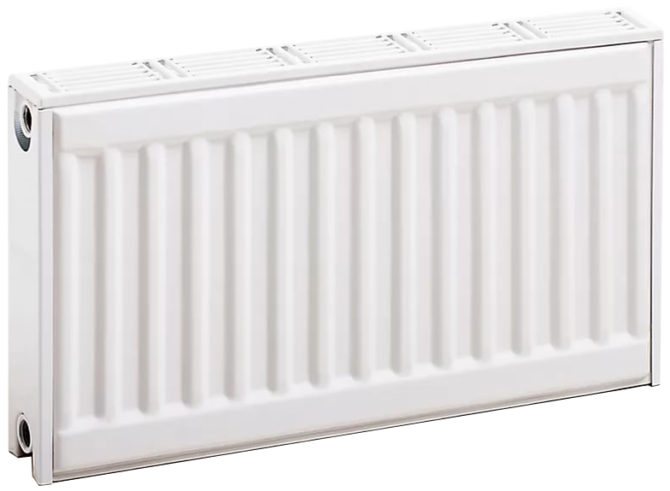

Radiator Prado Classic
The entire model range of the Universal series is equipped with thermostats and devices can be connected both from the side and from the bottom.
Radiators of the Classic series are not equipped with a thermostat and have a side connection only.
Comparison
Consider in the table the main technical characteristics of some of the described manufacturers of heating radiators.
| Manufacturer | Working pressure, Atm. | Max. coolant t, ° С | Power, W | Water volume, l | Weight, kg | Connection method |
| Kermi (Germany) | 10 | 110 | 965 | 2,7 | 17,07 | Lateral - thread 4 x 1/2 "(internal) Bottom - thread 2 x 3/4" (external) |
| Lidea (Belarus) | 8,6 | 110 | 1080 | 3,3 | 15,1 | Lateral - 4 connecting pipes with ½ internal thread Bottom - 2 connecting pipes with 1/2 ″ internal thread |
| Korado Radik (Czech Republic) | 10 | 110 | 914 | 2 | 15,6 | Side - thread 4 x 1/2 "(internal) Bottom - thread 2 x 3/4" (external) |
| Purmo (Finland) | 8,7 | 110 | 929 | 2,6 | 13,6 | Side - female thread 1/2 "Bottom - female thread 2 x 1/2" |
Not so many companies are engaged in the production of tubular radiators as panel radiators. They are expensive and mainly such products can be found from German manufacturers Zehnder Charleston, Arbonia, Kermi, Charleston.
An article about radiator manufacturers from Turkey, Finland and the Czech Republic is here

